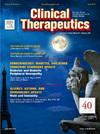The Efficacy Research of Prophylactic PEG-rhG-CSF in Preventing Neutropenia in Early-Stage Breast Cancer Patients Treated With Docetaxel-Based Chemotherapy: A Retrospective Analysis
IF 3.2
4区 医学
Q2 PHARMACOLOGY & PHARMACY
引用次数: 0
Abstract
Purpose
Docetaxel-based chemotherapy regimens (DBRs) are commonly used in the treatment of early-stage breast cancer (EBC). The prophylactic use of pegylated recombinant human granulocyte colony-stimulating factor (PEG-rhG-CSF) has been shown to reduce the incidence of neutropenia induced by DBRs. However, the clinical usage of PEG-rhG-CSF in EBC patients undergoing DBRs in China remains unclear.
Methods
This retrospective study was conducted in 137 EBC patients receiving DBRs from September 2022 to February 2024. We compared the incidence of chemotherapy-induced neutropenia (CIN) between patients who was treated with prophylactic PEG-rhG-CSF or not by complete blood counts, evaluating the effectiveness of PEG-rhG-CSF in preventing CIN. Prophylactic PEG-rhG-CSF was given at 100 μg/kg body weight (maximum total dosage of 6 mg) once 24–48 h following chemotherapy. Meanwhile, we also collected basic patient information, the area under time-concentration curve of docetaxel, and liver and kidney function indicators. Multivariate logistic regression and Receiver operating characteristic (ROC) curve analysis were employed to explore independent factors influencing neutropenia.
Findings
In this study, 87 of 137 EBC patients were administrated with prophylactic PEG-rhG-CSF, while 50 were not. Compared to patients who did not receive PEG-rhG-CSF, those who received prophylactic injections had a significantly lower incidence of grade 3–4 CIN (20% vs. 4.6%, P < 0.05). Higher body surface area (BSA), lower body mass index (BMI), elevated alanine aminotransferase (ALT), and nonprophylactic use of PEG-rhG-CSF were found to be positively correlated with CIN occurrence. ROC curve analysis indicated an area under the curve of 0.756 for predicting CIN in EBC patients when BSA was 1.66 m², BMI was 24.8 kg/m², and ALT was 41 U/L, with a sensitivity of 73.08% and specificity of 73.87%.
Implications
Prophylactic use of PEG-rhG-CSF significantly reduces the incidence of CIN, particularly grades 3 and 4. BSA, BMI, ALT, and PEG-rhG-CSF prophylaxis are independent influencing factors for the occurrence of neutropenia.
多西他赛化疗早期乳腺癌患者预防性 PEG-rhG-CSF 预防中性粒细胞减少症的疗效研究:回顾性分析。
目的:以多西他赛为基础的化疗方案(DBR)常用于治疗早期乳腺癌(EBC)。事实证明,预防性使用聚乙二醇重组人粒细胞集落刺激因子(PEG-rhG-CSF)可降低 DBRs 引起的中性粒细胞减少症的发生率。然而,PEG-rhG-CSF 在中国接受 DBR 的 EBC 患者中的临床应用情况仍不清楚:这项回顾性研究的对象是2022年9月至2024年2月接受DBRs治疗的137例EBC患者。我们通过全血细胞计数比较了接受预防性PEG-rhG-CSF治疗和未接受预防性PEG-rhG-CSF治疗患者的化疗诱发中性粒细胞减少症(CIN)发生率,评估了PEG-rhG-CSF在预防CIN方面的有效性。预防性 PEG-rhG-CSF 的剂量为 100 微克/公斤体重(最大总剂量为 6 毫克),在化疗后 24-48 小时服用一次。同时,我们还收集了患者的基本信息、多西他赛的时间-浓度曲线下面积以及肝肾功能指标。采用多变量逻辑回归和Receiver operating characteristic(ROC)曲线分析来探讨影响中性粒细胞减少症的独立因素:在这项研究中,137 例 EBC 患者中有 87 例接受了预防性 PEG-rhG-CSF,50 例未接受。与未接受 PEG-rhG-CSF 的患者相比,接受预防性注射的患者 3-4 级 CIN 的发生率明显较低(20% 对 4.6%,P<0.05)。研究发现,体表面积(BSA)较高、体重指数(BMI)较低、丙氨酸氨基转移酶(ALT)升高以及非预防性使用 PEG-rhG-CSF 与 CIN 发生率呈正相关。ROC 曲线分析表明,当 BSA 为 1.66 m²、BMI 为 24.8 kg/m²、ALT 为 41 U/L,预测 EBC 患者 CIN 的曲线下面积为 0.756,敏感性为 73.08%,特异性为 73.87%:意义:预防性使用 PEG-rhG-CSF 可显著降低 CIN 的发病率,尤其是 3 级和 4 级。BSA、BMI、ALT 和 PEG-rhG-CSF 预防是中性粒细胞减少症发生的独立影响因素。
本文章由计算机程序翻译,如有差异,请以英文原文为准。
求助全文
约1分钟内获得全文
求助全文
来源期刊

Clinical therapeutics
医学-药学
CiteScore
6.00
自引率
3.10%
发文量
154
审稿时长
9 weeks
期刊介绍:
Clinical Therapeutics provides peer-reviewed, rapid publication of recent developments in drug and other therapies as well as in diagnostics, pharmacoeconomics, health policy, treatment outcomes, and innovations in drug and biologics research. In addition Clinical Therapeutics features updates on specific topics collated by expert Topic Editors. Clinical Therapeutics is read by a large international audience of scientists and clinicians in a variety of research, academic, and clinical practice settings. Articles are indexed by all major biomedical abstracting databases.
 求助内容:
求助内容: 应助结果提醒方式:
应助结果提醒方式:


